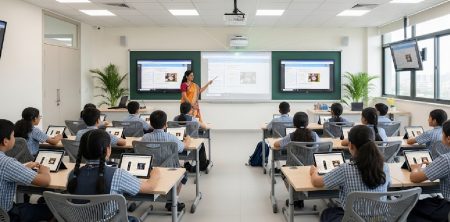The educational landscape is experiencing unprecedented transformation, driven by technological advancements and evolving pedagogical approaches. At the forefront of this revolution stands the modern teacher, increasingly partnering with innovative digital resources like kids animated shows to create more engaging, effective, and personalized learning experiences. This partnership between educators and animated content represents not merely a temporary trend but a fundamental shift in how educational content is delivered and consumed by young learners.
Educational technology experts predict that this integration will deepen significantly in coming years, with several emerging trends already gaining momentum. Adaptive animated content, which responds to individual learning patterns and adjusts difficulty levels accordingly, is being developed to address the perennial challenge of differentiated instruction. These smart animations track student comprehension through embedded assessments and modify subsequent content presentation—slowing down, providing additional examples, or accelerating based on demonstrated mastery.
The boundary between passive viewing and active participation is rapidly dissolving through interactive animated learning experiences. Unlike traditional video content, these new educational animations invite learner input through decision points, problem-solving challenges, and character direction. Teachers are finding that this interactivity substantially increases engagement and knowledge retention, as students become co-creators of the narrative rather than mere observers. The psychological principle of ownership—where we value more what we help create—explains why these interactive approaches often yield stronger learning outcomes.
Augmented reality (AR) represents another frontier where animation and education are converging productively. Forward-thinking educators are already experimenting with AR animations that overlay educational content onto the physical classroom environment. Students might point a tablet at their desk to see animated historical figures appear, watch mathematical concepts visualized in three-dimensional space, or observe virtual science experiments unfold before them. This technology bridges the gap between abstract concepts and tangible experiences, making learning more concrete for young minds.
The production of educational animated content is itself undergoing democratization. User-friendly animation software now allows teachers to create custom animated explanations tailored precisely to their curriculum needs and student population. This ability to generate bespoke educational animations means that content can be culturally relevant, aligned with specific learning objectives, and responsive to the particular needs of each classroom community—advantages that mass-produced content cannot match.
Artificial intelligence is enhancing the educational value of animated content through sophisticated natural language processing capabilities. Some emerging platforms allow students to actually converse with animated educational characters, asking questions and receiving explanatory responses. This technology enables a level of scaffolded learning previously impossible with passive media, as students can request clarification, additional examples, or simplified explanations when needed—creating truly responsive educational experiences.
The future also promises greater integration between animated educational content and learning management systems. Rather than existing as separate resources, animated lessons will increasingly be embedded within comprehensive digital learning environments where progress can be tracked, assessments administered, and personalized learning pathways developed. This integration provides teachers with valuable data on student engagement and comprehension, allowing for more targeted instructional interventions.
Virtual reality (VR) educational animations represent perhaps the most immersive frontier in this evolution. By placing students within animated educational environments—whether historical settings, scientific phenomena, or literary worlds—VR creates experiential learning opportunities previously impossible in traditional classrooms. Early research suggests that this immersive approach significantly enhances concept retention and transfer, particularly for spatial and procedural knowledge. Forward-looking schools are already establishing VR learning labs where animated educational content can be experienced in fully immersive environments.
The production quality of educational animations continues to rise as educational content creators adopt techniques from entertainment animation. This trend reflects growing recognition that aesthetic quality significantly impacts engagement—students are accustomed to high-quality animation in their recreational viewing and expect similar production values in educational content. This evolution challenges the false dichotomy between education and entertainment, recognizing that learning is most effective when it’s also engaging.
Collaborative viewing models are evolving alongside the content itself. Beyond the traditional whole-class viewing approach, teachers are exploring models where small groups interact with different animated content based on their learning needs, then share insights with peers. This approach maximizes the differentiation potential of animated resources while maintaining the benefits of collaborative learning and peer teaching.
Global collaboration through animated content represents another emerging trend. Classrooms in different countries increasingly share locally-produced animated stories reflecting their cultural contexts and experiences. This exchange of student-created animated narratives facilitates authentic cultural learning and global citizenship education in ways textbooks alone cannot achieve. Teachers report that these exchanges create memorable learning experiences that significantly impact students’ global awareness.
Professional development for educators is evolving to address these new teaching modalities. Teacher preparation programs increasingly include training on evaluating, selecting, and effectively implementing animated content. Additionally, online communities of practice allow educators to share strategies, resources, and lesson plans centered around specific educational animations—creating collaborative professional learning environments that transcend geographical limitations.
As we look toward the future, it seems certain that the relationship between education and animation will continue to deepen and evolve. The most forward-thinking educators recognize that animated content isn’t merely a supplement to traditional teaching but rather a transformative medium that can fundamentally enhance how children learn. By embracing these innovations thoughtfully and strategically, teachers position themselves at the forefront of educational evolution—not replacing traditional teaching wisdom but enhancing it with powerful new tools for engaging and educating young minds.
In this shared future, the line between teacher and technology blurs productively. Animated content provides scalable, consistent delivery of information, while teachers bring the irreplaceable human elements of inspiration, guidance, and emotional connection. It is in this complementary relationship—not in technology alone—that the true future of education lies.

